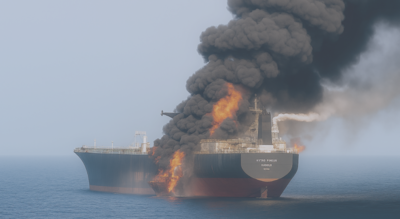ARTICLE AD BOX

The Front Eagle, carrying 2 million barrels of crude oil to Zhoushan, China, collided at 13.1 knots with the Adalynn, which was heading empty toward the Suez Canal/ Image resolution reconstructed with AI
In the early hours of Tuesday, June 17, two large vessels, oil tanker ADALYNN and cargo ship Front Eagle, collided approximately 24 nautical miles off the UAE’s eastern coast in the Gulf of Oman.
The incident, which occurred at around 1:30 a.m., resulted in minor hull damage to both ships, a small oil spill, and a fire that broke out in the fuel tank of one of the vessels, according to the UAE’s Ministry of Energy and Infrastructure (MoEI).According to TankerTrackers.com, the Front Eagle was moving southbound at 13.1 knots when it executed a starboard (right) turn, colliding with the aft port side of the Adalynn, which was moving southeast at 4.8 knots. The MoEI confirmed on Wednesday, June 18, that the accident was due to “navigational misjudgment by one of the vessels.” The fire was extinguished following prompt intervention by emergency teams, and no injuries were reported among the crew members of either ship.
The two vessels involved are:
- ADALYNN, a Suezmax-class oil tanker owned by India-based Global Shipping Holding Ltd, flying the flag of Antigua and Barbuda. It was sailing without cargo toward the Suez Canal in Egypt.
- Front Eagle, a Liberian-flagged cargo vessel owned by the Oslo-listed company Frontline. It was carrying 2 million barrels of Iraqi crude oil bound for Zhoushan, China.
Evacuation and Response
The UAE National Guard confirmed that 24 crew members aboard the ADALYNN were evacuated by search and rescue boats and taken to the Port of Khor Fakkan. Personnel aboard the Front Eagle were confirmed safe, and no pollution was reported on that vessel despite the fire on its deck.
According to Frontline, the fire on the Front Eagle was under control, and the incident is now under investigation, although the company emphasized that there was “no suggestion of outside interference.” A technical investigation is underway in cooperation with international maritime authorities. The MoEI assured that it would be conducted transparently and in accordance with the highest global maritime standards.
Geopolitical Context: Tensions in the Strait of Hormuz
The collision took place near the Strait of Hormuz, a narrow and strategic waterway that links the Gulf to the Gulf of Oman and the Arabian Sea. This area is critical, as about 20% of the world’s seaborne oi, between 17.8 and 20.8 million barrels per day, according to Vortexa, flows through this route. This maritime zone has recently experienced electronic interference, amid escalating military tensions between Iran and Israel. Since Friday, both countries have exchanged missile fire, and according to maritime security firm Ambrey, “the incident was not security-related.” Still, concerns remain. The Combined Maritime Force's JMIC information centre noted electronic signal interference in the region, particularly near Iran’s Bandar Abbas port. Although Tehran has not issued any comment on the collision or the reported electronic disruptions, its history of threatening to close the Strait of Hormuz in response to Western pressure has made the area increasingly volatile. As a result:
- Dozens of tankers were seen anchored in ports near Fujairah, Khor Fakkan, and Sharjah.
- Some shipping companies have paused operations or awaited charter decisions amid rising uncertainty.
- War risk insurance for ships heading to Israeli ports has increased, though rates for Gulf passages have remained stable, for now.
“Rates, for the time being, remain stable with no noticeable increases since the latest hostilities between Israel and Iran,” said David Smith, head of marine at insurance broker McGill and Partners.
“This position could change dramatically depending on any further escalation or general conflagration in the area.”
UAE's Emergency Preparedness and Past Rescues
The recent rescue underscores the UAE’s strong maritime emergency response. Just weeks earlier:
- On June 4, the National Guard airlifted an injured crew member in his fifties from a Marshall Islands-flagged oil tanker in UAE waters, flying him to a local hospital for urgent treatment.
- On May 18, 13 people were rescued from a sinking picnic boat, in an operation involving both citizens and residents.
These coordinated efforts signal a robust and well-prepared emergency response capability from UAE authorities, especially as regional tensions continue to rise.



.png)
.png)
.png)
















 3 hours ago
5
3 hours ago
5









 English (US) ·
English (US) ·